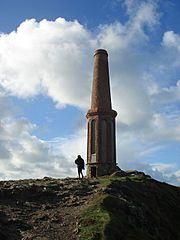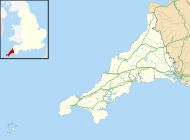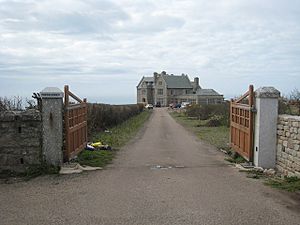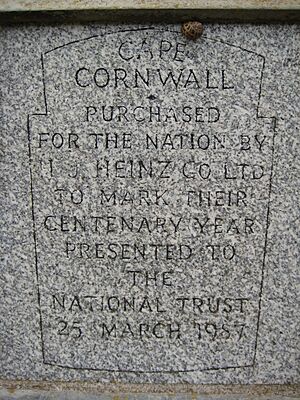Cape Cornwall Mine facts for kids

The 1864 chimney of Cape Cornwall Mine
|
|
| Location | |
|---|---|
| Location | St Just in Penwith |
| Country | United Kingdom |
| Coordinates | 50°07′37″N 5°42′33″W / 50.12694°N 5.70917°W |
| Production | |
| Products | Tin |
| History | |
| Active | 1838–1849, 1864–1875, 1879–1883 |
| Type: | Cultural |
| Criteria: | ii, iii, iv |
| Designated: | 2006 (30th session) |
| Reference #: | 1512 |
| State Party: | United Kingdom |
| Region: | Europe and North America |
The Cape Cornwall Mine was a tin mine located on Cape Cornwall. This cape is a piece of land sticking out into the sea at the very western tip of Cornwall, England, in the United Kingdom. The mine worked on and off between 1838 and 1883. After that, it closed for good, and its main engine building was taken down.
However, the mine's tall chimney, built in 1864, was kept. It stood near the top of the cape and helped ships find their way. Later, in the early 1900s, the areas where workers used to sort the ore were turned into greenhouses and places to make wine. In 1987, the H. J. Heinz Company gave the mine site to the country. Today, what's left of Cape Cornwall Mine is part of the Cornwall and West Devon Mining Landscape. This is a special area recognized as a UNESCO World Heritage Site.
Contents
History of Cape Cornwall Mine
When the Mine Opened and Closed
Cape Cornwall Mine first opened in 1838. This was during a time when mining was very popular in Cornwall. The mine was built right on Cape Cornwall, which is the most western point of Great Britain. It was about 1.2 miles (1.9 km) west of the town of St Just. This mine was quite small and not very famous. It closed down in 1849.
Reopening and the Famous Chimney
In 1864, the mine started working again. It was now owned by a group called St Just Consolidated Mines. They built a new engine house with a fancy chimney near the top of the cape. This engine house held the boiler for the mine's whim. A whim was a machine that lifted the valuable ore up to the surface.
The engine house and its boiler room were built lower down the hill. A long stone tunnel, called a flue, connected them to the chimney stack. Because there wasn't much flat space due to the steep cliffs, they added "spalling braces." These were platforms attached to the mine shaft. Workers used them to break the ore into smaller pieces for sorting. In 1869, St Just Consolidated Mines stopped owning Cape Cornwall Mine. But the mine kept running on its own until 1875.
The Chimney's Role and Final Closure
The mine reopened one more time in 1879. This time, it was owned by St Just United. There was a problem with the air flow, or chimney draught, in the 1864 chimney. So, in 1880, they stopped using that chimney. A new chimney was built further down the hill. However, the old 1864 chimney was still useful. It helped ships navigate, so it was not torn down.
Around this time, the mining industry in Cornwall was struggling. New laws, like the Metalliferous Mines Regulation Act of 1872, made it harder to use cheap labor. Before, many women and children worked in the mines. These laws limited that, which hurt the industry. In 1883, Cape Cornwall Mine closed for good. Soon after, the engine house was taken down.
In 1907, Francis Oats, who was in charge of the De Beers company, built Porthledden House. This was a large country house at Cape Cornwall. It was designed to look like another famous house called Groote Schuur. The old areas where ore was sorted were changed into greenhouses and places to grow grapes for wine. The cliffs around the house were planted with special flowers called mesembryanthemum.
Cape Cornwall: A World Heritage Site
Becoming Public Property
In 1987, the H. J. Heinz Company bought Cape Cornwall for the nation. They did this to celebrate 100 years of their business in the United Kingdom. Most of the mine site is now owned and looked after by the National Trust. Porthledden House is the only part that is still privately owned.
To remember Heinz's gift, there is a special plaque. It looks like a Heinz Baked Beanz label. This plaque is set into the base of the 1864 chimney. The remains of Cape Cornwall Mine are now part of the Cornwall and West Devon Mining Landscape. This whole area became a World Heritage Site in 2006.




